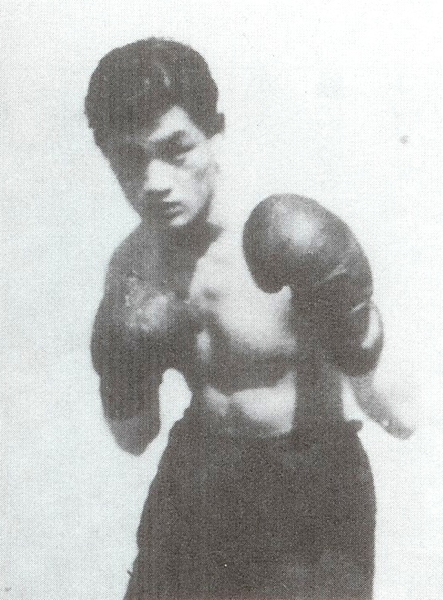 The boxer – Yoshio Kuriowa (黒岩洋志雄), 1932-2010
The boxer – Yoshio Kuriowa (黒岩洋志雄), 1932-2010
Yoshio Kuroiwa Sensei was one of the most original and innovative students at the post-war Aikikai Hombu Dojo, often integrating movements from his extensive knowledge of boxing into his Aikido. One of the strongest practitioners at the post-war Aikikai Hombu Dojo, his reputation led to an attempt by Gozo Shioda to recruit him into the Yoshinkan. Although he ultimately refused Shioda’s offer, he also refused all Aikikai rank promotions past sixth dan and gradually distanced himself from the post-Morihei Ueshiba Aikikai organization.
He was a participant in the first Aikido Journal Friendship Demonstration, along with Kanshu Sunadomari, Mitsugi Saotome, Morihiro Saito, Shoji Nishio and Yasuo Kobayashi, and published two articles in the Aikido Journal magazine: Training and Cognition and A Common Sense Look At Aikido.
If you are interested in Kuroiwa Sensei you may also with to read Ellis Amdur’s tribute to his passing from AikiWeb – In Memory of Kuroiwa Yoshio. In a separate interview Ellis also spoke about some of his recollections of Kuroiwa Sensei:
I particularly liked Kuroiwa Yoshio Sensei. He started training around 1954. He was six months junior to Kato Hiroshi Sensei, who broke his arm on the first class (laughs). Kuroiwa Sensei told me that Kato Sensei’s mother dragged him by the ear to his house to apologize to his mother. Kuroiwa Sensei was an interesting man; after World War II, there was a return to normality and boxing came up again. He probably fought over 200 bouts with no weight classes. Unlike a lot of the fellows who became Shihan at Hombu, he was not a middle class bourgeois, he came from Asakusabashi, in downtown Tokyo. He was a tough kid and he had that kind of anger that poor kids sometimes have. He used to walk around and pick fights with strong-looking high school or college students, knock them out, and steal their school badges as trophies. He took up Aikido when he realized that his ways were probably not the best for his own safety, hoping that Ueshiba Sensei might help him straighten himself up. The specificity of his practice was that he linked all of his techniques to boxing, not in terms of hitting but by putting every Aikido technique in a framework of hooks or uppercuts, never extending his arms, everything being a spiral on a figure-eight frame. For the rest of my Aikido time, he was my main influence.
This is the first part of a two part interview with Yoshio Kuroiwa that originally appeared in the January 2006 issue of Gekkan Hiden (月刊秘伝 / “Secret Teachings Monthly”), a well known martial arts magazine in Japan.
This interview was also published in a collection of interviews with students of the Founder published in Japanese as 開祖の横顔 (“Profiles of the Founder”) in 2009. There was a short introduction to this work in the article “Morihei Ueshiba – Profiles of the Founder“. A number of English translations of interviews from that collection appeared have appeared previously – Nobuyoshi Tamura Sensei (Part 1 | Part 2), Hiroshi Isoyama Sensei (Part 1 | Part 2), Shigenobu Okumura Sensei (Part 1 | Part 2), Nobuyuki Watanabe Sensei (Part 1 | Part 2), Masatake Fujita Sensei (Part 1 | Part 2) , Yoshimitsu Yamada Sensei (Part 1 | Part 2), Kanshu Sunadomari Sensei (Part 1 | Part 2) and Hiroshi Kato Sensei (Part 1 | Part 2).
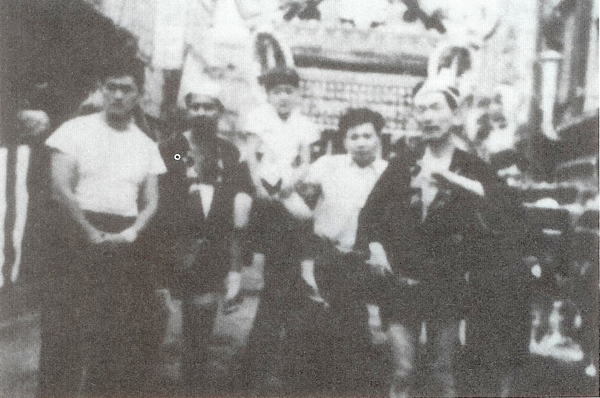 Yoshio Kuroiwa, left, at a Matsuri – Nobuyoshi Tamura second from right
Yoshio Kuroiwa, left, at a Matsuri – Nobuyoshi Tamura second from right
Interview with Aikido Shihan Yoshio Kuroiwa – Part 1
The Exhilarating Feeling of a Punch
Q: You were originally a boxer, how did you start boxing in the first place?
A: Well, none of my motives were pure. (laughing) Around the time of my second year in junior high school three no-goods took me into an alleyway in Jimbo-cho. Just as I thought “Whoa, I’m in trouble” the guy who was in front of me turned around to hit me and they took my money. I got angry and thought “No matter what, I’ll pay them back!”, so I cut apart a Kendo tsuba and made a set of brass knuckles. When I think about it now I wonder why I did that, though. (laughing) So…I wandered around the area where my money was taken, and after about three days the same guys came by and said “You, come here!”. They took me down that same alleyway! I thought “Here it comes!” and slipped on the brass knuckles in my pocket as I walked. When they turned around this time I smacked them, the guy in front wobbled and fell right over and the other two guys panicked. There wasn’t anything as exhilarating as the feeling of that punch. (laughing) I couldn’t forget that feeling, so I ended up joining a boxing gym.
Q: It was that exhilarating? (laughing)
A: Yes, even now after sixty years have passed I only remember bits and pieces. (laughing)
Q: Did you have difficulties after joining the boxing gym?
A: Of course, once you learn it you start wanting to use it. (laughing) At that time there were street vendors lining both sides of Ginza Dori, from Kyobashi to Shinbashi Nana-chome. There were a lot of different kinds of people walking around there, scruffy university students and others. When you looked those kinds of people in the face they would say “What the XXX are you looking at!?”. When that happened I would slip on the thin leather gloves that I had brought with me and follow them.
Q: So you would do them there? (laughing)
A: They all fell with one blow. (laughing)
Q: Was that a from a right cross?
A: No, it was a short left hook. That’s because when I talk about fighting it’s about close quarters combat. A short punch from the leading hand was the best.
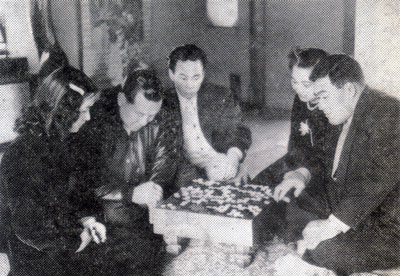 Masatatsu Oyama with Masahiko Kimura
Masatatsu Oyama with Masahiko Kimura
from “Aikido and Judo – Interview with Gozo Shioda and Masahiko Kimura“
Q: Oyama (Masatatsu) Sensei (大山 倍達, Founder of Kyokushin Karate) also said “In fighting it’s the short punch”, that’s the same, isn’t it?
A: Is that right? (laughing) I was stupid back then, so I would collect trophies from each one that I defeated. I really collected a lot! (laughing)
Is Aikido a cross between Karate and Judo?
Q: What was your reason for starting Aikido?
A: That wasn’t pure either. I was riding a bicycle about the time that I graduated from high school when a bicycle with a side-car that belonged to a bamboo pole shop came out from the side, and one of the bamboo poles stuck into the front wheel of my bicycle. Thanks to that I went tumbling forward with my bicycle. The onlookers gathered instantly – they were the ones who dashed out, I was the damaged party, but the other guy got the wrong idea. He swaggered towards me and grabbed me by the collar and said “Where were you looking you idiot!?”. When I blew my top and smacked him he fell right down, and then the police came and took me away. (laughing)
Q: (laughing)
A: Thankfully, the people around said “it was the bamboo pole shop’s fault”, so it all somehow worked out. Of course, the other guy was covered in blood, so in the end I had to pay for his medical expenses. Then I thought “I have to find a way to defeat an opponent without striking them”, and as I was considering things like Judo I came across a newspaper article introducing Aikido. In the article it said that Aikido was “a cross between Karate and Judo”, and I thought “that’s it!”. (laughing)
Q: (laughing) What happened with your boxing then?
A: By then I had damaged my eyesight, so I had already quit boxing. At that time one had to have an introduction in order to begin Aikido, so the reporter from Mainichi Housou (毎日放送) who was responsible for the article said “go ahead and use my name”, and that was the first time I went to see it. As an aside, I was already aware of the name “Aikido” at the time. There had been a small ad for an Aikido seminar in the Yomiuri Shimbun (読売新聞) in Showa year 23 (1948). I couldn’t decide whether to go or not right up until the seminar, but in the end I didn’t go. I didn’t really know what Aikido was then, so I thought that it must be some kind of Kiai-jutsu. I should have started back then. (laughing)
Q: Do you remember the first time that you went to the dojo?
A: I remember. I went there after lunch, so nobody was there. When I called out “Excuse me…” a person come out shouting “What is it!?” in a frightening voice. When I said “I’d like to become a student” they said “Do you know what Aikido is?”. Then when I said “it’s something like a cross between Karate and Judo” they got angry. (laughing) They made me sit in seiza at the side of the dojo where they hung the Keiko-gi and lectured me for about an hour – “Aikido connects Heaven and Earth…”. I couldn’t understand it at all – that was Sadateru Arikawa Sensei (有川定輝).
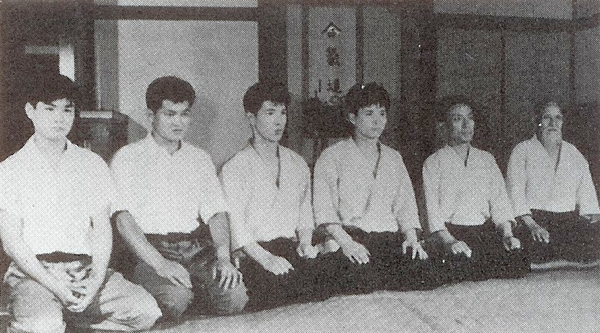 At the old Aikikai Hombu Dojo in 1959 – from right:
At the old Aikikai Hombu Dojo in 1959 – from right:
Morihei Ueshiba O-Sensei, Kisshomaru Ueshiba, Nobuyoshi Tamura,
Masamichi Noro, Yoshio Kuroiwa, Kazuo Chiba
Special Responses for Dojo Storming
Q: Who was in the dojo at that time?
A: There weren’t that many people there. The main people were Shigenobu Okumura (奥村繁信), Koichi Tohei (藤平光一), Kisaburo Osawa (大澤喜三郎), Sadateru Arikawa (有川定輝), Seigo Yamaguchi (山口清吾), Shoji Nishio (西尾昭二), Hiroshi Kato (加藤弘) and Nobuyoshi Tamura (田村信喜).
Q: There were some distinguished faces, weren’t there? I’ve heard that at the time you refined many techniques against dojo storming…did the other instructors do the same?
A: Yes, they did. After all, it was something of a brutal time. We had the kind of grit that said “No matter who comes we will protect the nameboard”. Noro (Masamichi) san (now head of “Ki no Michi” in Paris) said “When you grab their wrist you crush them right there”, and would swing a 10kg iron staff – he’d break his hand grips about once a month. Tada Sensei would swing the octagonal staff from the dojo with one hand. One person said “bite down on them and don’t let go even if lightning strikes”. (laughing)
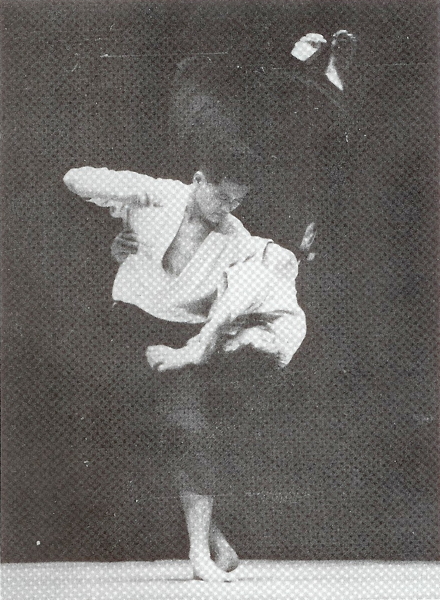 Yoshio Kuroiwa’s signature koshi-nage – straight down
Yoshio Kuroiwa’s signature koshi-nage – straight down
Q: And you had throwing techniques would drop them on their heads?
A: That’s right. Because it’s no use throwing them if they just get up again. I thought that dropping them on their heads would be the best way to damage them. In the end, though, I didn’t use that even once. Part of me feels good about that, and part of me regrets it. While I was training I’d think things like “If someone really comes (to break the dojo) will I be able to use it?”. There’s also the chance that one will be defeated.
Q: So part of you was also frightened?
A: It was frightening! It was frightening, but one couldn’t run away. That was the kind of time that it was. That’s why people who entered then never give up, their mental attitude is different – we had the feeling that “We must protect the dojo and build it up!”. By the way, people who started after that time didn’t have that same sense of impending danger, so a percentage of them just ended up quitting.
Gekkan Hiden January 2006
Published by: Christopher Li – Honolulu, HI

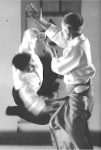
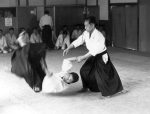




Leave a Reply